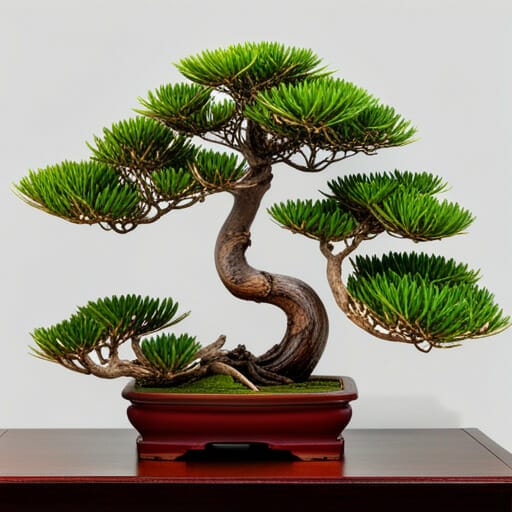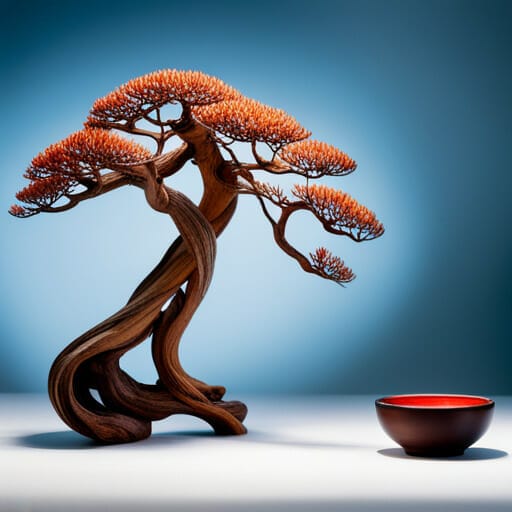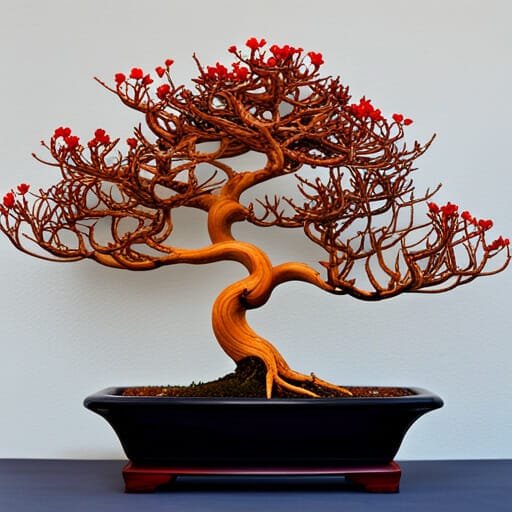Bonsai cultivation is a revered art form that requires meticulous attention to detail and a deep understanding of the techniques and principles involved. One such technique that adds a unique and captivating element to bonsai trees is the use of Jin and Shari, which create deadwood features.
Resinous trees such as pine, juniper, spruce, cedar, fir, yew, and larch are particularly suitable for this technique. In fact, statistics show that over 70% of bonsai enthusiasts incorporate Jin and Shari into their designs, highlighting its significance in the art form.
In this comprehensive guide, we will delve into the world of bonsai deadwood, exploring what Jin and Shari are and how to master the art of creating them. We will discuss the step-by-step process of creating Jin and Shari, including selecting the right area on the tree, choosing the appropriate species, and utilizing the necessary tools.
Furthermore, we will explore techniques for enhancing the aesthetic appeal of deadwood features, as well as tips for aftercare and maintenance. By mastering Jin and Shari, you will not only add a sense of age and natural beauty to your bonsai trees but also symbolize the cycle of life and death that is inherent in nature.
Contents
- 1 Quick Points
- 2 What is Jin and Shari?
- 3 Creating Jin and Shari
- 4 Techniques for Enhancing Aesthetic Appeal
- 5 Frequently Asked Questions
- 5.1 How long does it take for a wound to heal after creating Jin or Shari on a bonsai tree?
- 5.2 Can any type of tree be used for creating Jin and Shari, or are there specific species that work best?
- 5.3 Is it necessary to apply a preservative to the deadwood immediately after creating it, or can it be done at a later time?
- 5.4 What are the potential risks or drawbacks of creating Jin and Shari on a bonsai tree?
- 5.5 Are there any specific tools or techniques that can help prevent damage to the tree when creating Jin or Shari?
Quick Points
- Bonsai deadwood, known as Jin and Shari, is an important technique in bonsai that creates a sense of age, symbolizes life and death, and hides defaults.
- Resinous trees like pine, juniper, spruce, cedar, fir, yew, and larch are suitable for creating Jin and Shari in bonsai.
- When selecting areas for Jin and Shari, consider visual interest, overall balance, and creative shape.
– Tools required for creating Jin and Shari include bonsai scissors, pliers, carving tools, sandpaper, and a preservative like lime sulfur.
What is Jin and Shari?

Jin and Shari are techniques used in bonsai to create deadwood features on branches and the trunk, involving the removal of bark and sapwood to expose the natural wood underneath. These techniques are employed to enhance the aesthetic appeal of the bonsai, as well as to create a sense of age and symbolize life and death.
Jin refers to the deadwood features created on branches, while Shari is specifically used to create deadwood on the trunk.
When creating Jin and Shari, it is important to choose the right areas and species of trees, such as resinous trees like pine, juniper, spruce, cedar, fir, yew, and larch. Additionally, selecting the appropriate tools and applying a preservative, such as lime sulfur, are crucial steps in the process.
Overall, mastering Jin and Shari requires careful consideration, precise execution, and proper aftercare to achieve desired results in bonsai deadwood.
Creating Jin and Shari

Creating Jin and Shari involves carefully removing the bark from the trunk or branches of a bonsai tree to reveal the natural wood underneath, thereby adding a visual element that symbolizes the passage of time and the cycle of life. This technique requires precision and attention to detail to ensure the desired aesthetic effect is achieved. The process begins by selecting the right spot on the trunk or branch to create the Jin or Shari, taking into consideration both aesthetics and the health of surrounding branches. The bark is then removed using a sharp knife, carving tool, or plier, starting from the bottom and working upwards. Care must be taken not to remove too much bark, as this can be stressful for the tree. After the bark is removed, the sapwood is carefully carved away using a carving knife or chisels, being cautious to only remove the sapwood from the intended areas. The edge of the deadwood is then carved to refine the boundary between the Shari and the living portion of the tree. Finally, the surface of the exposed wood is smoothed using a sanding tool, and a preservative, such as lime sulfur, is applied a few months later to protect the deadwood from decay and insects.
| Steps for Creating Jin | Steps for Creating Shari |
|---|---|
| 1. Select the right branch | 1. Choose the right spot on the trunk |
| 2. Prune foliage | 2. Remove bark |
| 3. Remove bark | 3. Remove sapwood |
| 4. Remove sapwood | 4. Carve edge |
| 5. Carve edge | 5. Smooth surface |
| 6. Sand deadwood | 6. Apply preservative |
Techniques for Enhancing Aesthetic Appeal

Techniques used in the art of bonsai involve enhancing the aesthetic appeal of the tree by utilizing various methods to highlight the natural beauty and create visual interest. When it comes to creating Jin and Shari, these deadwood features can be further enhanced to elevate the overall aesthetic appeal of the bonsai.
Here are three techniques that can be used to achieve this:
- Texturing: Adding texture to the deadwood surfaces can create a more realistic and aged appearance. This can be done by using tools like wire brushes or sandpaper to create grooves, ridges, or roughness on the deadwood.
- Coloring: Applying stains or dyes to the deadwood can enhance its visual impact. This can be done by using natural substances like tea, coffee, or vinegar, or by using commercial wood stains specifically designed for bonsai.
- Moss and lichen: Allowing moss or lichen to grow on the deadwood can create a sense of naturalness and add to the overall aesthetic appeal. This can be achieved by regularly misting the deadwood with water and providing the right conditions for moss and lichen growth.
By incorporating these techniques, bonsai enthusiasts can further enhance the visual interest and appeal of Jin and Shari, creating stunning and captivating bonsai compositions.
Frequently Asked Questions
How long does it take for a wound to heal after creating Jin or Shari on a bonsai tree?
The healing time for wounds created during the process of creating Jin or Shari on a bonsai tree varies and can take several months. It is important to wait until the wound has healed before applying a preservative to avoid interfering with water absorption.
Can any type of tree be used for creating Jin and Shari, or are there specific species that work best?
Specific species of trees are best suited for creating jin and shari in bonsai. Resinous trees like pine, juniper, spruce, cedar, fir, yew, and larch are commonly chosen due to their ability to develop naturally whitish dead branches, enhancing the aesthetic appeal of the bonsai.
Is it necessary to apply a preservative to the deadwood immediately after creating it, or can it be done at a later time?
Applying a preservative to the deadwood immediately after creation may damage the wound and hinder water absorption. It is safer to apply the preservative when the wound has healed, which is typically a few months later.
What are the potential risks or drawbacks of creating Jin and Shari on a bonsai tree?
Potential risks or drawbacks of creating Jin and Shari on a bonsai tree include stress to the tree, potential damage to live branches if sapwood is removed incorrectly, and the risk of over-removing bark, which can be harmful.
Are there any specific tools or techniques that can help prevent damage to the tree when creating Jin or Shari?
To prevent damage to the bonsai tree when creating Jin or Shari, it is important to use the right tools and techniques. Tools such as bonsai scissors, pliers, carving tools, and sandpaper can help in careful removal of bark and sapwood. Additionally, it is crucial to avoid cutting off the sapwood in the middle and to carve the edge of the deadwood to refine the boundary between Shari and the living portion. Following these practices can help minimize harm to the tree and ensure successful creation of Jin and Shari.




